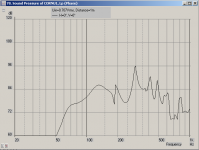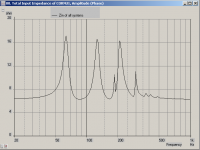Pics:
I see there is still a little glue string and a grill cloth tuck needed in the middle pick. Oops.
Wow! Very nice looking. The oil turned out very nice and adding the trim frame with fabric really makes it look polished and professional looking. Congratulations on being done!

Now relax and enjoy the sound!
Except for the fact that my dinner is getting cold, I am happy too.Cal,
Thanks for the minute play by play with your adjustments.
WTF is a spectrum analyzer? Sounds like something that should be left to a doctor.Are you using a spectrum analyzer? Even software one using the computer mic is helpful.
Software is what my wife calls me when I can't...umm...you know.
I will experiment over the next few days, but at this point we are good, not great, but really, really good good.I am listening to mine now and think that I must have just gotten lucky with the light stuffing i put in the throat.
Thank you. I have enjoyed the journey.Wow! Very nice looking.
OK, those are instructions I can follow.Now relax and enjoy the sound!

Software is what my wife calls me when I can't...umm...you know.
made me LOL

Except for the fact that my dinner is getting cold, I am happy too.
WTF is a spectrum analyzer? Sounds like something that should be left to a doctor.
Software is what my wife calls me when I can't...umm...you know.
I will experiment over the next few days, but at this point we are good, not great, but really, really good good.
That's hilarious. Not sure if you are sharing too much there Cal
I use FrequenSee for the spectrum analyzer, works on Android phone or tablet. There is probably a pc version, but gives you instantaneous real time graph of sound pressure (arbitrary units) vs frequency. Pretty handy for checking speaker response.
https://play.google.com/store/apps/details?id=com.DanielBach.FrequenSee&hl=en
Tight, that's what leads me to believe is was getting close to aperiodic.
Do you mean bass is tight or stuffing is tight? When you say aperiodic, you mean there is no resonance peak?
... How do you model the split lengths?
Like this:
Code:
Throat +-- Horn 2 -- Radiator
Radiator --Driver -- Chamber -- Horn 1 --+
+---- Horn 3 ---- Radiator... Do you mind scaling it to 20 in (50 cm) and running it with the Vifa tc9fd ...
See attached. I assumed 6 cm depth. It doesn't look good... I think the volume (depth) is too small and the horn is tuned too low.
... Also, at the 70 cm, the longest path should get down to about 38 Hz, the sim shows falloff below 50 Hz. ...
It is what it is. The impedance and excursion graphs (of the 70x70 cm model) show resonances at 61 and 119 Hz. I suspect the bifurcated horn is the problem. The longer of the two "output" horns is 138 cm, which is 1/4 wavelength at 62 Hz. That's why I want to re-sim with equal length horns.
Attachments
makes my horn look pretty good on the bass side of things 
see: http://www.diyaudio.com/forums/full...-board-speaker-enclosures-10.html#post3274505 for my graph (grey trace) ill post up the rest of the graph tomorrow.
see: http://www.diyaudio.com/forums/full...-board-speaker-enclosures-10.html#post3274505 for my graph (grey trace) ill post up the rest of the graph tomorrow.
Last edited:
Like this:
Code:Throat +-- Horn 2 -- Radiator Radiator --Driver -- Chamber -- Horn 1 --+ +---- Horn 3 ---- Radiator
See attached. I assumed 6 cm depth. It doesn't look good... I think the volume (depth) is too small and the horn is tuned too low.
It is what it is. The impedance and excursion graphs (of the 70x70 cm model) show resonances at 61 and 119 Hz. I suspect the bifurcated horn is the problem. The longer of the two "output" horns is 138 cm, which is 1/4 wavelength at 62 Hz. That's why I want to re-sim with equal length horns.
Don,
Thank you for running the simulation. This is good stuff
Regarding the simulation and the bifurcation, I have my doubts about what really happens physically - that is, is it really a bifurcated horn, or is the bifurcation channel (the split) really acting as a divider rib to the longer horn with an average length between the shorter and longer one? Also, could it be additional horn resonances - there are 4 different lengths if you look at the combination of possibilities. Nonetheless, this is awesome what you have done. I am new to using this modeling tool - would you mind attaching the input file/script or whatever is needed to run the simulation as a file attachment to a post on this thread? I am not new to mathematical simulations, as I use Mathcad all the time, I am just not familiar with akabak.
Regards,
Xrk971
Last edited:
Don Hills,
One more question. Does your sim model the outputs of the radiators combined with effect of room walls to redistribute and mix everything like MJK's models? The room may be the effect that makes these sound great as the output from all edges is key to design, and placement in room is critical.
Thanks,
Xrk971
One more question. Does your sim model the outputs of the radiators combined with effect of room walls to redistribute and mix everything like MJK's models? The room may be the effect that makes these sound great as the output from all edges is key to design, and placement in room is critical.
Thanks,
Xrk971
Last edited:
Like this:
Code:Throat +-- Horn 2 -- Radiator Radiator --Driver -- Chamber -- Horn 1 --+ +---- Horn 3 ---- Radiator
See attached. I assumed 6 cm depth. It doesn't look good... I think the volume (depth) is too small and the horn is tuned too low.
It is what it is. The impedance and excursion graphs (of the 70x70 cm model) show resonances at 61 and 119 Hz. I suspect the bifurcated horn is the problem. The longer of the two "output" horns is 138 cm, which is 1/4 wavelength at 62 Hz. That's why I want to re-sim with equal length horns.
Don, could you share your simulation script? I'd like to simulate with a different driver and in the same time play a bit with the model.
@sprokeT i get mine from officeworks. Its not "cheap" at 10.30 a sheet, but it is compared to the price of wood. And it comes in different colours. Check the posterboard section.
ahh yeah thats where i saw it. I think 3mm MDf might be cheaper. (going to look into that) there is a aussies website that sells it too. The offcuts section looked promising.
Last edited:
Ouch!!!Even in Australian dollars, $10/sheet hurts.
Ive thought about using old pallets at work, because they are free.
Im pretty sure mdf is cheaper here that plywood. (at least at the hardware stores)
ok, so its very late here, and im way too many bourbons past being able to work things out matematically....
Would it be possible to scale this up to use the 6x9's I have sitting in front of me. Or would it have to be stupidly big.
BTW Cal, they look top shelf, and are an inspiration!
Would it be possible to scale this up to use the 6x9's I have sitting in front of me. Or would it have to be stupidly big.
BTW Cal, they look top shelf, and are an inspiration!
- Home
- Loudspeakers
- Full Range
- Foam Core Board Speaker Enclosures?

